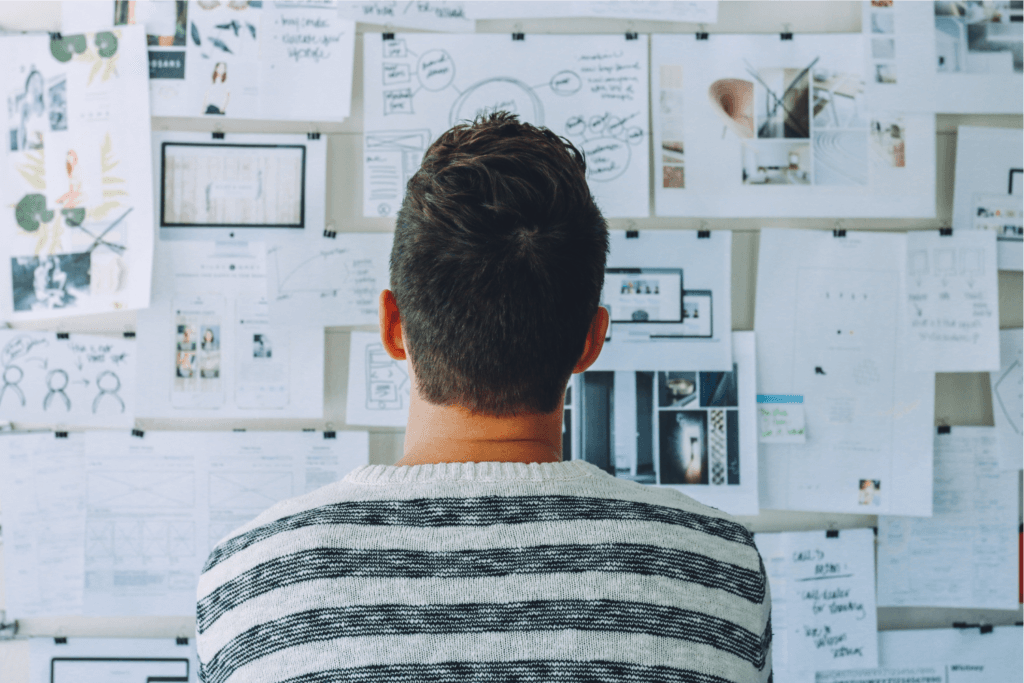Moodboarding in IT is a key element of visual planning, helping to express emotion and design direction. Understanding the process of creating a Moodboard, its important elements and using the appropriate Moodboard tools are essential for effective work on the project.

Moodboard is an invaluable tool in the world of design, especially in the context of the IT industry, where visual communication and clear presentation of concepts are crucial to success. Creating an effective Moodboard can be not only inspiring, but also functional, helping to define the design aesthetic and convey the mood and direction expected of the final product.
In this article, we will explore how creating a Moodboard can contribute to a better understanding and achievement of project goals by facilitating communication between all parties involved in the project.
What is a Moodboard and why is it important in an IT project?
Moodboard in IT is a visual tool that helps project teams communicate the overall concept and direction of the project. It is a collection of images, textures, colors and other graphic elements that together create a coherent image of a future application or system. By using Moodboard, the design team can more easily agree on the project vision, ensuring that all team members have a common understanding of the project’s goals and aesthetics.
In an IT context, Moodboard is particularly important because it helps transform abstract technical ideas into concrete visual elements. This tool facilitates communication between the technical team and the creative team, as well as with clients who may not have technical knowledge.
Moodboard enables all parties involved to better understand the intended project outcomes and helps avoid misunderstandings or ambiguities in later stages of development.
Key elements of an effective Moodboard in an IT context
For a Moodboard to be effective in an IT project, it should contain certain key elements. First of all, it should be visually appealing and reflect the intended design aesthetic. This includes choosing colors, typography, user interface styles, as well as images and graphics that match the intended feel and style of the app.
Moreover, an effective Moodboard in IT should be adapted to the project goals and its recipients. It should take into account the specificity of the industry for which the project is being created, as well as the preferences and expectations of end users. It is important that the Moodboard is flexible and can be easily updated as the project evolves, allowing for adaptation to changing requirements and feedback from the client.
How to create a Moodboard for an IT project step by step?
Creating a Moodboard in an IT context is a process that requires both creativity and systematicity. It is a tool that allows design teams to visualize and present the aesthetic direction of a project. An effective Moodboard can significantly influence the final shape of the application, supporting visual consistency and facilitating communication within the team.
The work on creating a Moodboard can be presented in the following steps:
- Defining the purpose of the Moodboard – at the beginning of the process, it is important to define what the Moodboard in IT is supposed to represent. This goal shapes all subsequent stages of Moodboard creation.
- Collecting inspiration – the next step is to collect inspiration materials that can help visualize your future project. An effective collection of inspirations allows for a better understanding of the intended aesthetic directions.
- Choosing a Moodboard Creation Tool – The right tool is crucial for effective Moodboard creation. It should enable easy management and presentation of collected materials.
- Organization and selection of materials – the next stage involves the selection and organization of the collected elements. In this step, it is decided which materials best reflect the goals of the project.
- Creating a Moodboard layout – it should be intuitive and aesthetically consistent to effectively communicate the intended direction of the project.
Review and adjustment of the Moodboard – after creating the initial version of the Moodboard, you should evaluate it and make any corrections based on the feedback received.
Using a Moodboard in a Design – The final Moodboard should serve as a reference point for all subsequent design decisions, ensuring aesthetic consistency.
Creating a Moodboard is a key stage in the design process in the IT industry. It allows you to effectively convey the visual aspects of the design and ensures aesthetic consistency at all stages of development. By following the steps presented, you can create an effective communication tool that will support the success of the entire project.
Examples of using Moodboards in the IT industry
Moodboard has become an integral element of the design process in the IT industry, especially when it comes to strengthening design communication. Thanks to their visual nature, Moodboards can be used at various stages of the project – from the conceptual phase to the final refinement of user interfaces.
One example of using Moodboard is the initial stage of designing a mobile application. Using Moodboard, the design team can quickly communicate and agree on the colors, typography and overall visual style of the application. Thanks to this, at an early stage, all team members have a clear picture of the expected result, which promotes effective work and minimizes the risk of misunderstandings.
Another scenario where Moodboard significantly influences design communication is the redesign of an existing website. Moodboard can be used to present new aesthetic directions, inspirations, and potential changes to the interface. This enables clients and the design team to better understand the intended changes and speeds up the process of approving a new website look.
In the context of software development, Moodboard is also used to present and discuss user interfaces, animations and micro-interactions, which are crucial to the user experience. By visually presenting these elements, the team can better assess whether the proposed solutions are consistent with the overall product vision, which in turn translates into a higher quality of the final application.
Moodboard is an invaluable tool in teamwork because it allows team members from different disciplines – such as designers, developers, product managers – to collaborate effectively and share the vision of the project. By using Moodboard in the project communication process, teams can avoid ambiguity, increase work efficiency and achieve better results in less time.
Tools and applications for creating Moodboards
Choosing the right Moodboard tools is crucial for effective and efficient design in the IT industry. There are a number of apps and platforms that allow you to create inspiring and functional Moodboards. Below we present some of them that have gained recognition among industry professionals.
The first recommended tool for Moodboards is Pinterest. This popular platform allows users to create personalized inspiration boards where they can pin images, links and videos. Pinterest is especially useful for collecting inspiration and organizing it into thematic categories. Importantly, it is easy to use and available on multiple devices, making it a favorite tool of many designers.
Another tool, Canva, offers a wide range of features for designing Moodboards. In addition to traditional options such as inserting images and text, Canva also enables team collaboration in real time. This is especially valuable in projects where communication and cooperation between team members is crucial.
Another noteworthy tool for Moodboards is Adobe Spark. This app offers a rich library of templates that can serve as a starting point for creating your own Moodboards. Users can also add their own images, text and other elements, making this app a versatile tool for designers of all skill levels.
Mural is another app that has gained popularity among design professionals. It’s a cloud-based tool that allows you to create Moodboards and collaborate on them with your team in real time. Mural offers a wide range of features, including the ability to add notes, comments and votes, making it easier to exchange ideas and make design decisions.
The last Moodboard tool discussed is Milanote. This platform is particularly appreciated for its flexibility and the ability to create complex Moodboards containing texts, images, links and files. Milanote also offers a collaboration option, which allows teams to exchange thoughts and ideas effectively.
Choosing the right tool for Moodboards depends on the individual needs of the designer and the specifics of the project. It is important that the tool used is intuitive to use, enables effective organization of materials and supports team cooperation.
How can Moodboard help you communicate with your team and client?
Moodboard is an essential tool in project communication that facilitates the expression and exchange of creative vision between team members and between the team and the client. Its use helps transform abstract ideas into concrete visual form, making the design easier to understand and accept.
Within the team, Moodboard becomes a common language that transcends differences in specialization and experience. It enables presentation and discussion about aesthetics, functionality and the overall direction of the project, which contributes to better team integration and more effective work.
In turn, in relations with the client, Moodboard acts as a communication bridge, explaining not only the intended aesthetic directions, but also showing how these concepts fit into the business goals of the project. With this tool, clients can better understand the team’s proposals, leading to faster approval and fewer reworks.
Challenges and pitfalls when creating Moodboards in an IT project
Creating a Moodboard may encounter a number of challenges and pitfalls, especially in the context of IT projects. The first is excessive abstraction, which can lead to misunderstandings. It is important that the Moodboard is understandable to all project participants, including people without technical or design experience.
Another pitfall is the lack of consistency between the Moodboard and the actual technical capabilities of the project. The moodboard should reflect not only aesthetic aspirations, but also be realistic in the context of the tools, technology and budget available for the project.
Additionally, there is a risk that Moodboard will be treated as a rigid template and not as a source of inspiration. This is especially dangerous when the team becomes too attached to early concepts and is not open to adaptations or changes resulting from further development of the project or feedback from the client.
You should also avoid focusing too much on just one aspect, such as color or typography, at the expense of other important elements. A moodboard should be a balanced presentation of different aspects of the design to provide a holistic approach to design.
Moodboard is not only a tool supporting creativity, but above all a key factor in improving communication in IT projects. By visually communicating concepts, Moodboards enable the effective exchange of ideas between team members and help to clearly present the project vision to clients. However, the effective use of Moodboards requires a careful approach to their creation and use, taking into account the specificity of the project and the needs of all parties involved.






